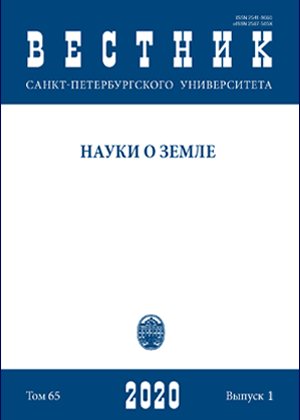Lithogeochemistry of clastic rocks of the Mashak Formation (western slope of the South Urals): in search of “camouflaged” pyroclastics
DOI:
https://doi.org/10.21638/spbu07.2020.107Abstract
The article attempts to solve the problem of the presence of “camouflaged” pyroclastics in sandstones and fine-grained clastic rocks of the Middle Riphean Mashak Formation of the Southern Urals based on litho- and geochemical methods and approaches. As a result of the studies, it was established that in the NKM–GM diagram, the compositional field of silt-clayey rocks of the Mashak Formation is comparable with several clusters of Jurassic slates of the Greater Caucasus, containing volcanogenic material, while the clusters of Paleogene tuffs of the Ukrainian Carpathians and the Gromashor Formation (Pai-Khoi) have a different location. On the (Na2O + K2O) – GM diagram, in the indicated field, are situated two of four clusters of
metatuffoids and mixed volcanic-sedimentary rocks of the Strelna Group (Kola Peninsula), and one of two clusters of tuffs of the Redkino horizon (Vendian of the East European Platform). The same is true for a number of other examples. In the diagram (Na2O + K2O) – FM, none of the four clusters of tuffs and tuffopelites of the Ordovician of the Arga-Tas zone of the Momsky horst-anticlinorium and none of the six clusters of acidic tuffs and tuffites of Ukrainian Carpathians fit in, etc. Consequently, the localization of the compositional field of silt-clayey rocks of the Mashak Formation in the above and a number of other diagrams shows that clusters of various volcanic-terrigenous rocks, metatuffosiltstones, metatuffoids, slates, etc., containing a certain admixture of volcanic products, coincide with the diagrams in half or fewer of the cases. Thus, the analysis of the absolute contents and indicator ratios of trace elements inherent in sandstones and clayey rocks, values of petrochemical modules and the systematics of rare-earth elements (REE) does not allow us to state with certainty that magmatic processes, including subsynchronous sedimentation, were the main source of their constituent material.
Keywords:
Southern Urals, Middle Riphean, Mashak Formation, sandstones, clay rocks, lithogeochemistry
Downloads
References
Downloads
Published
How to Cite
Issue
Section
License
Articles of "Vestnik of Saint Petersburg University. Earth Sciences" are open access distributed under the terms of the License Agreement with Saint Petersburg State University, which permits to the authors unrestricted distribution and self-archiving free of charge.






